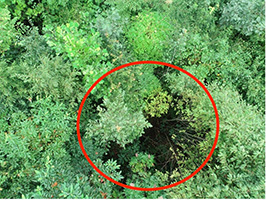Testing efficacy of underplanting and enrichment plantings for stand regeneration in hardwood forests
Testing efficacy of underplanting and enrichment plantings for stand regeneration in hardwood forests
 Oaks (Quercus spp.) and other valuable hardwood species provide important economic, ecological, and wildlife values, but regeneration failures in natural forests are common. Underplanting and enrichment plantings may provide an alternative means to increase the abundance and diversity of advance reproduction of desirable hardwoods in the forest understory. Most of these studies have been short-term, however, with relatively few extending beyond 10 years. Thus, a more comprehensive knowledge of the longer term responses of underplanting and enrichment plantings is needed. We propose to take advantage of a network of existing HTIRC / Purdue FNR underplanting and enrichment planting demonstration trials and research experiments established over the past 20 years in natural forest stands on FNR woodlands throughout Indiana, with three main objectives. In Objective 1, we will assess long-term performance of underplanting and enrichment plantings across this network of sites. Using this data and an assessment of site conditions, we will develop models to best explain relative long-term success or failure of these plantings. For Objective 2, we will use a sub-set of trials from those in Objective 1 that are at the appropriate developmental stage and have sufficient stocking of future crop trees to examine responses to release from competition. In Objective 3, we will establish and maintain these sites as a network of demonstration trials to be used as a resource for HTIRC / Purdue FNR Extension field days to communicate results of these long-term trials to landowners and foresters. Our project will enhance knowledge of the long-term responses of these plantings specific to the relatively mesic site conditions characterizing Indiana and the surrounding region.
Oaks (Quercus spp.) and other valuable hardwood species provide important economic, ecological, and wildlife values, but regeneration failures in natural forests are common. Underplanting and enrichment plantings may provide an alternative means to increase the abundance and diversity of advance reproduction of desirable hardwoods in the forest understory. Most of these studies have been short-term, however, with relatively few extending beyond 10 years. Thus, a more comprehensive knowledge of the longer term responses of underplanting and enrichment plantings is needed. We propose to take advantage of a network of existing HTIRC / Purdue FNR underplanting and enrichment planting demonstration trials and research experiments established over the past 20 years in natural forest stands on FNR woodlands throughout Indiana, with three main objectives. In Objective 1, we will assess long-term performance of underplanting and enrichment plantings across this network of sites. Using this data and an assessment of site conditions, we will develop models to best explain relative long-term success or failure of these plantings. For Objective 2, we will use a sub-set of trials from those in Objective 1 that are at the appropriate developmental stage and have sufficient stocking of future crop trees to examine responses to release from competition. In Objective 3, we will establish and maintain these sites as a network of demonstration trials to be used as a resource for HTIRC / Purdue FNR Extension field days to communicate results of these long-term trials to landowners and foresters. Our project will enhance knowledge of the long-term responses of these plantings specific to the relatively mesic site conditions characterizing Indiana and the surrounding region.
(Funding: HTIRC)
